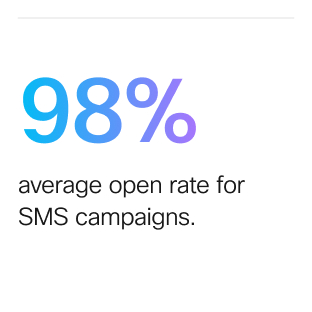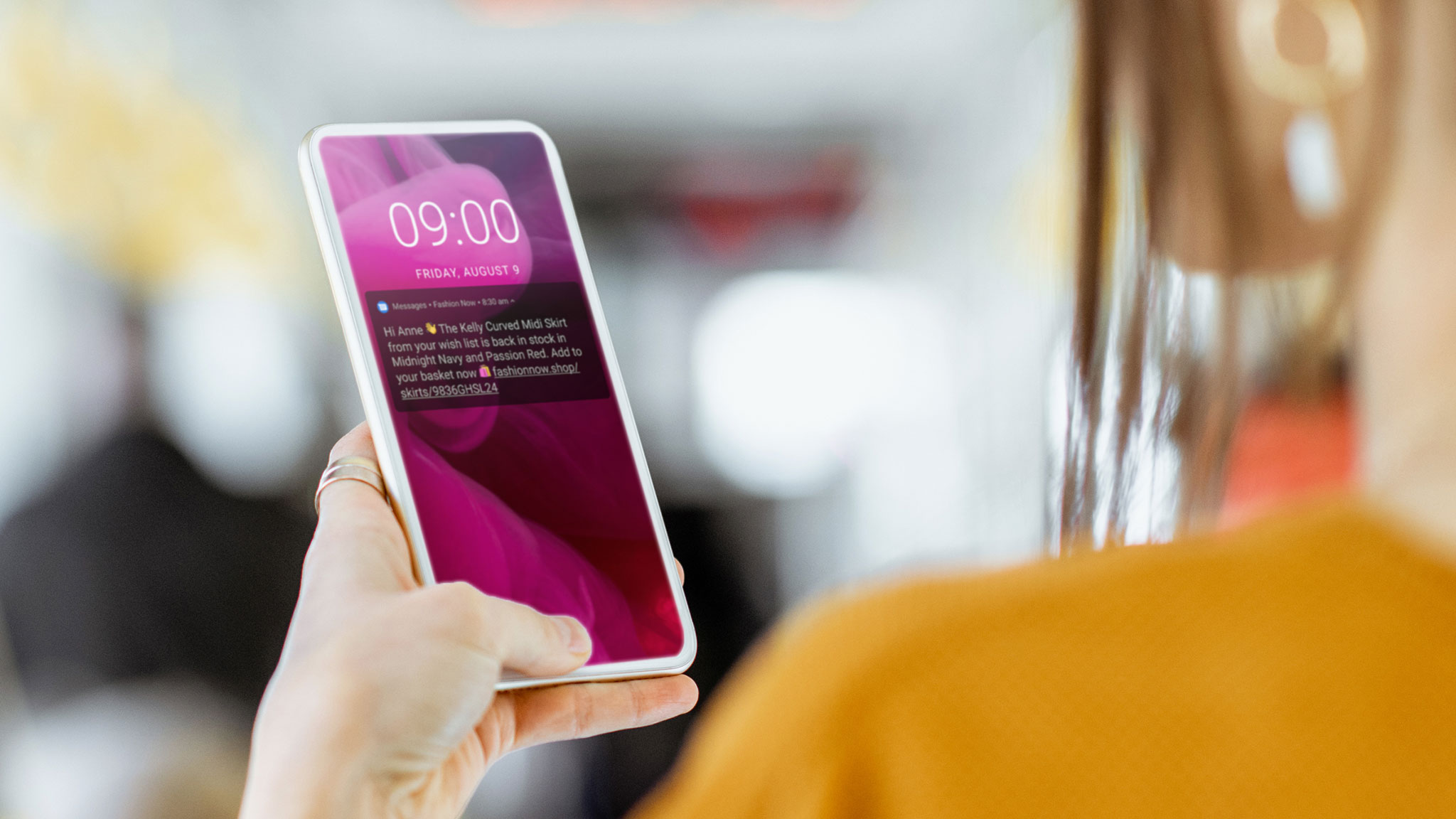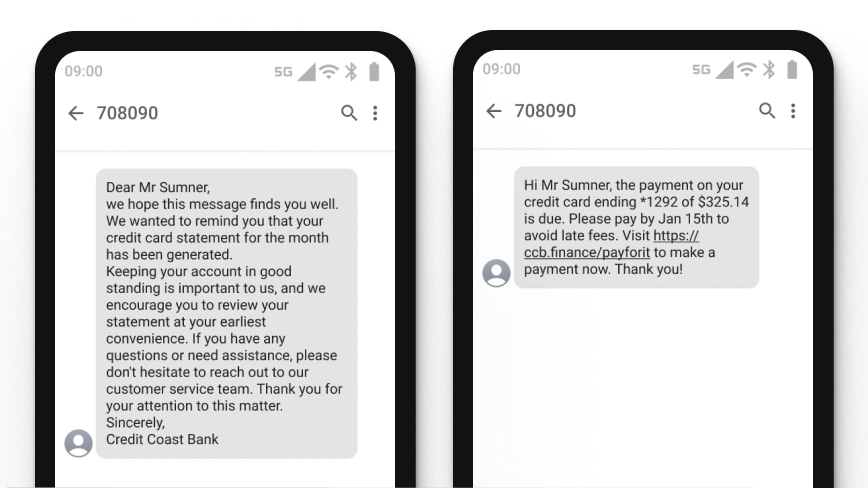SMS marketing best practices to engage, delight and nurture.
What does it take to deliver a wildly successful SMS marketing campaign? Join us as we explore some the essential SMS marketing techniques and best practices.
Contents
Secure, private, and cost-effective—SMS gives you a trusted and direct channel to your customers. And despite it being an older channel, SMS is an increasingly popular marketing tool.

Between May 2022 and May 2023, 86% of businesses used SMS marketing, a 56% rise in SMS adoption over the same period a year before. And it’s working too with SMS campaigns getting an average open rate of 98%.
So, what does it take to join the businesses using SMS to great effect and deliver effective SMS marketing messages?
We unpack six SMS marketing best practices for SMS marketing success, including how to deliver timely and strategic SMS campaigns that engage, promote, and inform. For more tips on SMS marketing strategy and uses cases read our SMS marketing guide.
1. Always get the customer’s permission
This should be your number one priority before you hit send on any recurring SMS marketing messages, even if it’s to your existing customers. SMS is an intimate channel, and sending unwanted messages can make a customer feel like their personal—albeit digital—space is being invaded.
Make sure to:
Offer obvious opt-in/out options by automating simple “opt-in” and “opt-out” dialogue for all initial SMS interactions to avoid alienating customers and damaging any previously earned goodwill.
Inform customers how often you intend to message them and whether there are any carrier costs or fees.
What might that look like? Imagine a customer is coming to the end of their mobile service contract. The network seizes the opportunity to retain the customer by sending them a personalized text offering a 12-month contract renewal including an extra 5GB of data and full device protection at no added cost.
The clearly branded text lets the customer reply “Y” to proceed with the renewal or “N” to opt out of the service and all future SMS interactions. It’s quick, simple, and respects the customer’s boundaries.
Global SMS guidelines
Remember, many regions have strict regulations that outline what you can and can’t send to customers by SMS. So always check local guidelines to avoid incurring fines and other nasty surprises. Check out this article to find out more on global SMS guidelines.
2. Nurture trust with authentic branding
Your customers likely receive thousands of messages a year and they need to know exactly who you are. If there’s any doubt, they may dismiss or report a legitimate text as fraudulent. Plus, using unbranded messages allows fraudsters to impersonate you with something that, unhelpfully, could look more convincing than your genuine comms.
As per TCPA guidelines, ensure each message includes your business name and a unique signifier—such as your logo or tagline as a sign-off. Using a Communications-Platform-as-a-Service (CPaaS) solution with branded sms capabilities and proactive fraud management can go a long way to nurturing and retaining customer trust.
Introducing Branded Text
With Branded Text provide your SMS customers with a rich messaging experience that includes your company logo and a verification mark to demonstrate your authenticity. Deliver a seamless CX at a nominal cost with no technical changes required.

Showing SMS on the left versus branded SMS message on the right.
Your brand logo will appear in the title bar and conversation window, and a verified sender checkmark will show you’ve been authorized as a real business. Every customer’s device is accounted for too. If their device can’t support the Branded Text experience, they’ll receive a traditional SMS version by default.
Use Branded Text to protect your customers against fraud. Find out more in how to get started with our handy datasheet.
3. Timing is everything in SMS marketing
SMS is a great way to inform your customers with timely and context-aware notifications and about the latest promotions. Real-time information that makes your customers’ lives easier and enhances the brand experience are essential to SMS marketing best practices.
Whether you’re a retailer dispatching a much anticipated pre-order or a bank that’s just approved a customer’s mortgage on their first home, effective SMS marketing messages can help you seize the moment and demonstrate your customer-centric service.

For example consider sending SMS notifications for:
Appointment reminders
Wishlist discounts
Restock notifications
Travel and booking updates
Billing notifications
But as always, take care to respect your customers' boundaries and time zones. For example, French mobile networks block marketing SMS traffic between 10pm and 8am on weekdays and on Sundays and public and bank holidays. Don’t text customers early in the morning or late at night, and remember local SMS guidelines.
4. Personalize to stand out from the crowd
To successfully follow SMS marketing best practices, it’s crucial that you only send relevant texts. So, we recommend segmenting your customers based on the quantifiable data they’ve agreed to share with you.
Measure your customer's:
Browsing habits
Product preferences
Service usage
Engagement history
All of these insights and more, depending on your services, can help tailor your SMS campaigns to resonate better with your target audiences. You may also find that this data opens up opportunities to cross-sell and up-sell relevant products and services.
Imagine a customer buys a yoga outfit from a major department store. Shortly after, the customer receives a text with a discounted offer for an online yoga platform and a list of recommended classes popular with the customer’s demographic. This thoughtful interaction strengthens their connection with the brand and adds value to the customer journey.
What’s more, using dynamic tags for customer names and other recurring templates elements can help add small, personalized flourishes at scale. However, not every customer will be delighted by the same things, which leads us to our final best practice.
5. Be clear and succinct
SMS may open the door for ongoing dialogues but be careful not to overshare.
Be clear, concise, and aware of SMS limitations—namely, the 160-character limit. Longer texts will typically appear as a single batch of multiple messages, which is ideal for more complicated interactions such as with customer support and self-service chatbots. We also recommend focusing on a single call-to-action to increase conversion rates. For example, if you tell a customer that their appointment needs rescheduling, don’t offer them a discount at the same time.
When in doubt, remember this quote from Constellation Research:
Don’t’ waste space. Be short and concise. Be brief. Be brilliant. And be gone.Liz Miller, Vice President and Principal Analyst at Constellation Research:

Showing the difference between a concise SMS with a clear CTA, versus a longer SMS message where the CTA is unclear.
6. Use customer data
With the right CPaaS platform, you can integrate your backend systems with customer-facing channels to seamlessly exchange data and inform your marketing interactions.
By centralizing all your customer communications in a single platform, you can also test and identify the messaging that resonates with your customers, based on campaign performance, much more easily.
SMS marketing tip: A/B test a bold or humorous tone of voice. Further optimize and segment audiences based on their responses.
You may find that SMS isn’t always the right channel to drive engagement at a specific stage of the marketing funnel. You might find better results by blending email and SMS marketing together to support certain marketing messages. Here again, the right CPaaS solution can be a huge help, allowing you to orchestrate a customer journey that’s both seamless and omnichannel.
Discover SMS success with Webex Connect
Webex Connect is an enterprise-grade CPaaS purpose-built to help organizations across all industries automate customer journeys, offering:
One and two-way SMS
Send SMS leveraging two-way messaging across 40+ countries, enabling customers to respond with a few taps of the screen.
Speed
Avoid unnecessary message hops with our carrier-agnostic hub and intelligent routing, ensuring your communications take the optimal route every time.
Fraud controls
Integrated global compliance and a resilient Tier 1 messaging network, you get peace of mind that your SMS campaign will always take the fastest and safest route to your prospects and customers.
Get in touch today to discuss these SMS marketing best practices and how SMS marketing works with Webex Connect.
Frequently asked questions
-
How often should you use SMS marketing?
The best practice for SMS marketing frequency is to strike a balance. You want to stay top-of-mind without overwhelming your customers. Generally, sending 2-4 messages per month is a good starting point and based on customer preferences, message them with content they are likely to read. Always monitor engagement and feedback to adjust your frequency as needed. Remember, quality over quantity is key.
-
How long should an SMS marketing message be?
An SMS marketing message should be clear and concise, ideally sticking to the 160-character limit. This ensures your message is delivered as a single text and keeps your communication straightforward. If you need to share more information, consider using a link to a landing page or a follow-up message.
-
How can I improve my SMS deliverability?
Improving SMS deliverability involves several best practices:
Get permission: Always obtain explicit opt-in consent from your customers.
Use clear branding: Ensure your messages are clearly branded to build trust.
Respect timing: Send messages at appropriate times, considering time zones and local regulations.
Maintain clean lists: Regularly update your contact lists to remove inactive or incorrect numbers.
Monitor performance: Use analytics to track delivery rates and adjust your strategy accordingly.
-
What are the pros and cons of SMS marketing?
Pros:
High open rates: SMS messages boast an impressive open rate of around 98%, ensuring your message is seen.
Wide reach: Almost everyone has a mobile phone, giving you access to a broad audience. On top of whish SMS works without an internet connection, making it accessible anywhere.
Cost-effective: SMS marketing is generally more affordable compared to other marketing channels and is much easier to implement.
Cons:
Character limit: SMS messages are limited to 160 characters, which can restrict the amount of information you can share.
Susceptible to phishing scams: SMS can be vulnerable to phishing scams, which may cause customers to be wary and less likely to engage compared to more secure channels.
Limited media support: Unlike MMS or RCS, SMS does not support rich media like images or videos.
-
How to collect data for SMS marketing?
Collecting and analyzing data for SMS marketing is crucial for understanding performance and optimizing your campaigns. Here are some key data points and methods to consider:
1. Delivery rates: Track the percentage of messages successfully delivered to your recipients. High delivery rates indicate a clean and accurate contact list.
2. Open rates and click throughs: While SMS open rates are generally high, monitoring them can help you understand how engaging your messages are. If your SMS includes links, track the CTR to see how many recipients are engaging with your call-to-action.
3. Opt-out rates: Monitor the rate at which recipients unsubscribe from your SMS list. High opt-out rates may indicate that your messages are too frequent or not relevant.
4. Engagement metrics: Look at metrics such as the time of day when messages are most effective, the types of messages that get the best responses, and the overall engagement trends over time.
5. Feedback surveys: Collect feedback directly from your customers through follow-up surveys or direct responses to your SMS campaigns. This qualitative data can provide insights into customer preferences and areas for improvement.
Using a CPaaS platform like Webex Connect will allow you pull all these data points effortlessly.